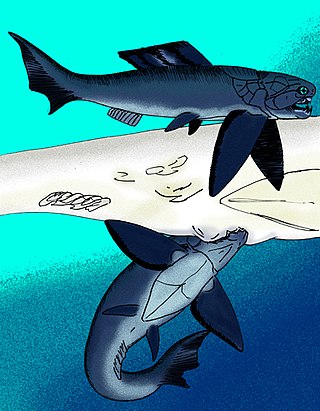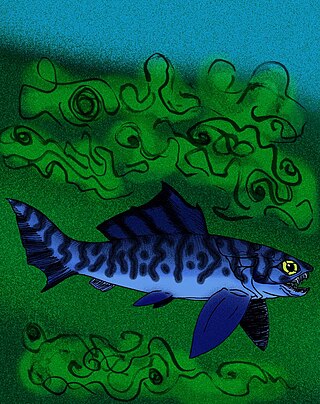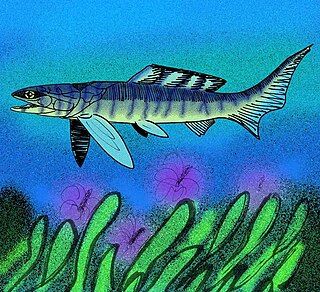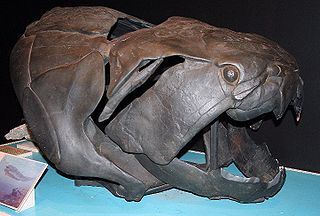
Dinichthys is an extinct monospecific genus of large marine arthrodire placoderm from the Late Devonian measuring around 3 metres (9.8 ft) long. Fossils were recovered from the Ohio Shale Formation along the Olentangy River in Delaware County, Ohio.

Brachythoraci is an extinct suborder of arthrodire placoderms, armored fish most diverse during the Devonian.
Heintzichthys is an extinct monospecific genus of arthrodire placoderm that lived what is now Europe and North America during the Famennian stage of the Late Devonian period. The type specimen was discovered in the Cleveland Shale near Cleveland, Ohio, in the United States.

Bruntonichthys is an extinct monospecific genus of arthrodire placoderm from the Early Frasnian stage of the Late Devonian period. Fossils are found in the Gogo Formation of the Kimberley region of Australia. The skull is about 139 millimetres long, and had disproportionally large eye sockets. Researchers suggest it may have preyed on small mollusks.

Fallacosteus is an extinct monospecific genus of arthrodire placoderm from the Early Frasnian stage of the Late Devonian period, found at the Gogo Formation of Kimberley, Western Australia. As with almost all other camuropiscids, F. turneri had an elongated snout that may have enhanced its hydrodynamic streamlining.

Camuropiscis is an extinct genus of arthrodire placoderm from the Early Frasnian stage of the Late Devonian period, found at the Gogo Formation of Kimberley, Western Australia. The species of Camuropiscis had a flattened, elongated snout that may have aided in enhancing its hydrodynamic streamlining.

Latocamurus is an extinct monospecific genus of flat-nosed arthrodire placoderm from the Early Frasnian stage of the Late Devonian period, found at the Gogo Formation of Kimberley, Western Australia.

Hadrosteus is an extinct monospecific genus of large arthrodire placoderm from the Late Frasnian Kellwasserkalk facies of Bad Wildungen, Germany. It had large, double-pronged inferognathals, and serrated edges along its mandible, strongly suggesting that it was a fish-eating predator. The head had a triangular snout, and the trunkshield was short, but high, with a median dorsal plate that was broader than wide. The average skull length is about 16 centimeters.

Gymnotrachelus is an extinct monospecific genus of large selenosteid arthrodire placoderm of the Late Devonian known from the Late Famennian Cleveland Shale of Ohio. The type species Gymnotrachelus hydei was originally reconstructed as physically resembling Selenosteus, with slightly smaller orbits. Later specimens led to a reappraisal, and now G. hydei is thought to have a more gar-like or barracuda-like build.

Coccosteidae is a family of arthrodire placoderms from the Early to Late Devonian. Fossils appear in various strata in Europe, North America and China.

Kiangyousteus is an extinct monotypic genus of dunkleosteid from the Middle Devonian: Givetian aged Guanwu Formation in the Sichuan province of south-western China. The type species, Kiangyousteus yohii, was the first known arthrodire from Asia.

Dunkleosteoidea is an extinct superfamily of arthrodire placoderms that lived during the Devonian period. The gigantic apex predator Dunkleosteus terrelli is the best known member of this group.

Harrytoombsia is an extinct genus of arthrodire placoderm from the Early Frasnian stage of the Late Devonian period. Fossils are found from Kimberley, Australia. It was a fast-swimming predator, and it had sharp blades of enamel-like material around the outer edge of the jaw for catching prey.

Eubrachythoraci is an extinct clade of arthrodire placoderms within the suborder Brachythoraci, armored fish most diverse during the Devonian. Most are considered to be pelagic long-distance swimmers, leading to their widespread distribution beginning from at least the Middle Devonian period.

Pachyosteomorphi is an extinct clade of arthrodire placoderms within the Eubrachythoraci, armored fish most diverse during the Devonian. Most are considered to be pelagic long-distance swimmers, leading to their widespread distribution beginning from at least the Middle Devonian period.

Coccosteomorphi is an extinct clade of arthrodire placoderms within the Eubrachythoraci, armored fish most diverse during the Devonian. Most are considered to be pelagic long-distance swimmers, leading to their widespread distribution beginning from at least the Middle Devonian period.

Trematosteus is an extinct monospecific genus of arthrodire placoderm from the Late Frasnian stage of the Late Devonian period. Fossils are found from Bad Wildungen, Germany.
Tapinosteus is an extinct monospecific genus of arthrodire placoderm from the Late Frasnian stage of the Late Devonian period. Fossils are found from Bad Wildungen, Germany.
Bullerichthys is an extinct monospecific genus of arthrodire placoderm from the Early Frasnian stage of the Late Devonian period. Fossils are found in the Gogo Formation of the Kimberley region of Australia. It was thought to be durophagous, meaning that it preyed upon hard-shelled creatures such as mollusks.
Brachyosteus is an extinct genus of arthrodire placoderm from the Late Frasnian stage of the Late Devonian period. Fossils are found from Bad Wildungen, Germany.





















